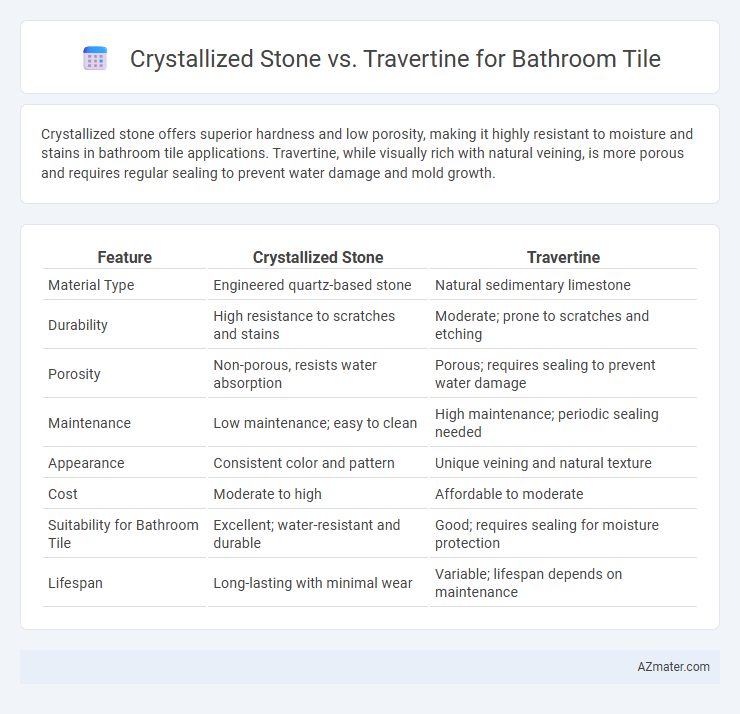Crystallized stone offers superior hardness and low porosity, making it highly resistant to moisture and stains in bathroom tile applications. Travertine, while visually rich with natural veining, is more porous and requires regular sealing to prevent water damage and mold growth.
Table of Comparison
| Feature | Crystallized Stone | Travertine |
|---|---|---|
| Material Type | Engineered quartz-based stone | Natural sedimentary limestone |
| Durability | High resistance to scratches and stains | Moderate; prone to scratches and etching |
| Porosity | Non-porous, resists water absorption | Porous; requires sealing to prevent water damage |
| Maintenance | Low maintenance; easy to clean | High maintenance; periodic sealing needed |
| Appearance | Consistent color and pattern | Unique veining and natural texture |
| Cost | Moderate to high | Affordable to moderate |
| Suitability for Bathroom Tile | Excellent; water-resistant and durable | Good; requires sealing for moisture protection |
| Lifespan | Long-lasting with minimal wear | Variable; lifespan depends on maintenance |
Introduction: Comparing Crystallized Stone and Travertine
Crystallized stone tiles offer exceptional durability and a polished, glass-like finish, making them ideal for high-moisture bathroom environments. Travertine provides a natural, porous texture with warm, earthy tones that create a classic, rustic aesthetic but requires sealing to prevent moisture damage. Choosing between crystallized stone and travertine depends on balancing maintenance needs with desired style and durability for bathroom tile applications.
What is Crystallized Stone?
Crystallized stone is a durable, engineered material made by fusing natural stone particles with resin and pigments under high heat and pressure, resulting in a non-porous, stain-resistant surface ideal for bathroom tiles. Unlike travertine, which is a natural, porous limestone characterized by its textured surface and requires sealing to prevent water damage, crystallized stone offers higher resistance to moisture and easier maintenance. Its uniform appearance and enhanced durability make crystallized stone a practical choice for high-traffic bathroom areas compared to the more porous and softer travertine.
What is Travertine?
Travertine is a natural limestone formed by mineral deposits from hot springs, characterized by its porous texture and earthy tones, making it a popular choice for bathroom tiles due to its warm, natural appearance. Crystallized stone, often known as polished or engineered stone, offers a denser, less porous surface with enhanced durability and stain resistance compared to natural travertine. Choosing travertine for bathroom tiles balances aesthetic appeal with the need for regular sealing to maintain its longevity in moist environments.
Appearance and Aesthetic Differences
Crystallized stone tiles exhibit a smooth, glossy surface with a shimmering effect created by tightly packed natural crystals, offering a luxurious and polished aesthetic ideal for modern bathroom designs. Travertine features a more rustic appearance with porous textures and natural pits, providing a warm, earthy look that enhances traditional or Mediterranean-style bathrooms. The visual contrast lies in crystallized stone's refined shine versus travertine's matte, textured finish, influencing the overall ambiance and style of the bathroom space.
Durability and Hardness
Crystallized stone offers superior durability and hardness compared to travertine, making it more resistant to scratches, stains, and wear in bathroom environments. Travertine, a natural limestone, is softer and more porous, requiring regular sealing to prevent damage and maintain its appearance. For long-lasting bathroom tile solutions, crystallized stone provides enhanced strength and minimal maintenance.
Water Resistance and Suitability for Wet Areas
Crystallized stone exhibits superior water resistance compared to travertine, making it highly suitable for bathroom tiles and wet areas due to its dense, non-porous surface that resists moisture absorption and staining. Travertine, a natural limestone, tends to be more porous and softer, requiring regular sealing to protect against water damage and mold growth in humid environments. The enhanced durability and low-maintenance properties of crystallized stone provide a more practical and long-lasting solution for wet bathroom settings.
Maintenance and Cleaning Requirements
Crystallized stone tiles offer superior durability and resistance to stains, making maintenance easier with regular sweeping and occasional mopping using pH-neutral cleaners. Travertine requires more frequent sealing to protect against moisture and staining, along with gentle cleaning agents to avoid surface etching. Both materials benefit from avoiding acidic or abrasive cleaners, but crystallized stone typically demands less intensive upkeep than travertine in bathroom environments.
Cost Comparison: Crystallized Stone vs Travertine
Crystallized stone bathroom tiles generally cost more than travertine, with prices ranging between $15 to $30 per square foot compared to travertine's $10 to $25 per square foot. The higher cost of crystallized stone is attributed to its enhanced durability and resistance to moisture, making it a long-term investment for bathroom flooring. Travertine offers a more budget-friendly option but may require additional sealing and maintenance to prevent water damage.
Installation Considerations for Bathroom Tiles
Crystallized stone tiles require precise cutting tools and professional installation due to their hardness and brittleness, which can impact labor costs and time. Travertine tiles are softer and more porous, necessitating sealing before and after installation to prevent water absorption and staining in bathrooms. Both materials demand a moisture-resistant substrate and proper grout sealing to ensure durability and maintain aesthetic appeal in humid bathroom environments.
Which is Better for Bathroom Tiles: Crystallized Stone or Travertine?
Crystallized stone offers superior durability and low porosity, making it highly resistant to water absorption and staining, which is ideal for bathroom tiles. Travertine provides a natural, textured appearance but requires regular sealing to prevent moisture damage and is more prone to etching from bathroom chemicals. For long-term maintenance and moisture resistance, crystallized stone is generally the better choice for bathroom tile installations.

Infographic: Crystallized stone vs Travertine for Bathroom Tile
 azmater.com
azmater.com